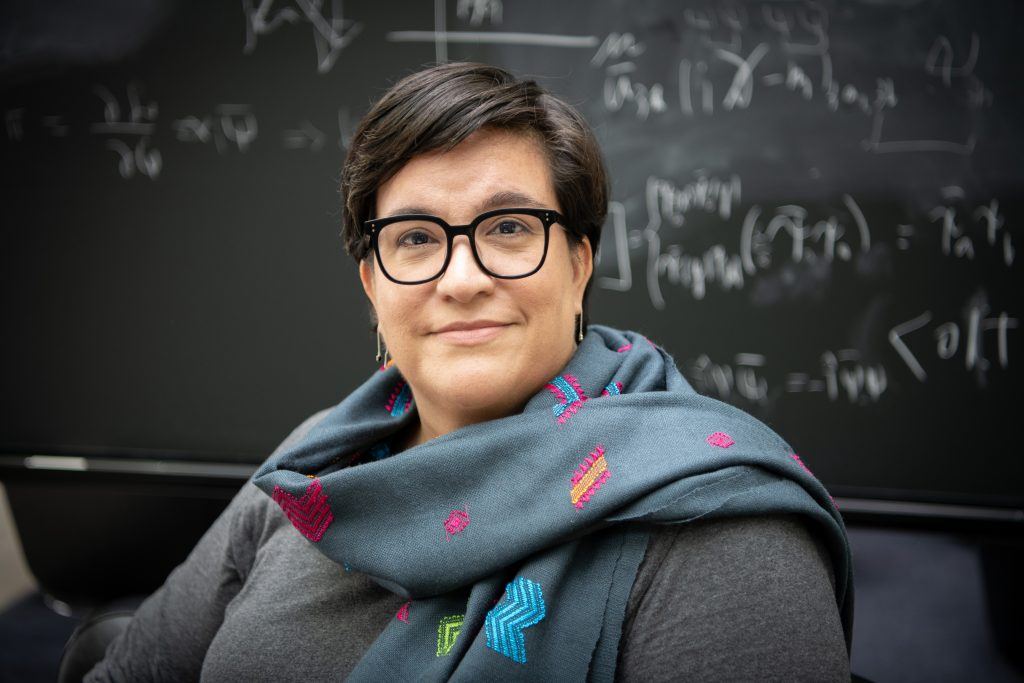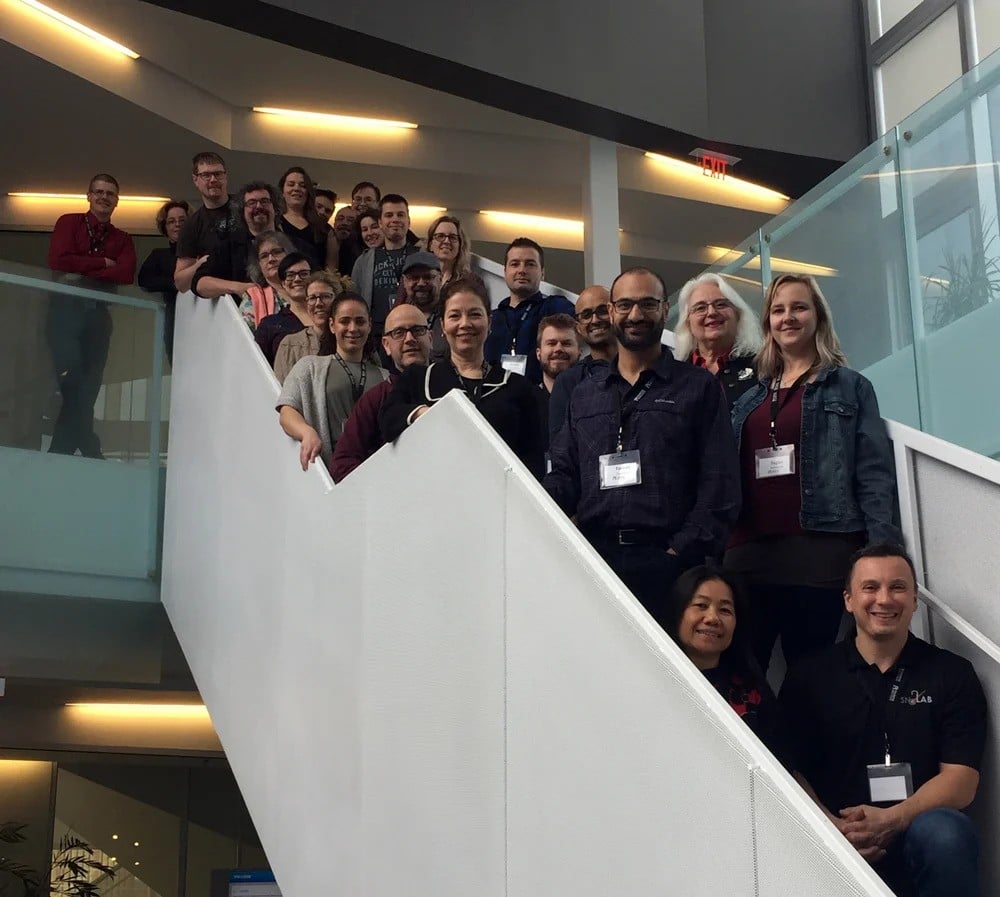It’s a snowy -13°C in Waterloo, Ontario and four visitors are flying in from Colima, Mexico. Their flight is mostly Canadians returning from vacations, some still wearing shorts and sandals, their tan lines still visible.
“I told my colleagues, ‘We are the only people on this plane excited about going toward the snow,’” laughs Malena Tejeda-Yeomans, a Simons Emmy Noether Fellow and Director of the Faculty of Sciences at Universidad de Colima.
As a researcher, Tejeda-Yeomans studies heavy-ion collisions that recreate the first moments after the big bang. One day during her fellowship at Perimeter in 2022, she saw that the Outreach team was hosting an event for high school students.
“I asked for a meeting right away because Universidad de Colima has a role in the high school system, and we do many things with high school teachers,” says Tejeda-Yeomans. “When I learned Perimeter had an outreach program, I wanted to find a way for our teachers to be part of it.”
When Tejeda-Yeomans went home, she started knocking on doors for funding and a formal commitment from the University. The result? A five-year strategy that is expanding Perimeter’s Teacher Network to Mexico, starting with three new graduates of Perimeter’s EinsteinPlus teacher workshop.
A shortage of STEM undergrads
Tajeda-Yeomans notes that enrollment in physics and math are low compared to other faculties at her university. In response, they have created various programs to bring highschoolers to campus, including workshops, a program called the ‘Heisenberg Institute,’ and Saturday classes.
“We try to run activities that offer students a taste of what it means to be a professional scientist,” Tejeda-Yeomans says. “But also in our system, physics and math teachers have such a high workload that staying current is hard.”
High school teachers in Mexico teach more than one subject for 40 hours per week, in multiple locations throughout the region. Lesson preparation and travel time are done on a teacher’s own time. Tejeda-Yeomans recalls her parents – both high school chemistry and math teachers – spending their weekends working with foam balls to craft models of molecules and brainstorming other ways to be creative in the classroom.
One of the teachers who joined Tejeda-Yeomans at Perimeter teaches math and physics at four different high schools. He travels to two schools per day across the mountains, city, and semi-rural areas. Another teacher in the program has a PhD in Engineering that included research at the University of Waterloo, and teaches math and physics at two schools located at different points along the Manzanillo coast. Sometimes they are working with 40-50 students in a single classroom.
“As science moves forward, you need to be in touch with international communities, not just local ones. So the opportunity to be here, in this particular way of doing things like they do at Perimeter, it is the only program where high school teachers are being trained in this way,” says Tejeda-Yeomans. “The style, the way the activities are designed, the way the booklets and worksheets are designed, is all amazing.”
Perimeter’s Teacher Network
Formally launched in 2009, Perimeter Institute’s Teacher Network provides teachers with the tools needed to reach additional educators in their region through professional development workshops. Members deliver workshops and provide feedback on Perimeter teacher resources that are in development in partnership with Perimeter scientists and the Outreach team.
In year one of Colima’s strategy, Tejeda-Yeomans’ team created a local network of teachers and trained them in Colima, starting with the teachers that had received previous training from organizations like Fermilab. From that network, they selected teachers to come to EinsteinPlus, and have offered in-person and online training. Eventually, the plan is to bring Perimeter’s outreach team to Colima.
“This opportunity for the teachers goes both ways,” says Tejeda-Yeomans. “First, they have to excel at English, because science is done in an international arena. You need to be able to read technical stuff and communicate your ideas in English.”
She adds that soft skills, like critical thinking, keeping their knowledge current, and presentation skills are equally important.
“These are practices from modern scientists,” says Tejeda-Yeomans. “Teachers need to present STEM as a real opportunity for the younger generation.”
Mexico’s future STEM workforce
Despite the shortage of STEM-based university students, Colima and Mexico in general is a growing market for STEM-based jobs. Colima is home to Mexico’s largest port, a prime location in need of STEM-trained professionals like engineers, operations managers, and people working in material sciences.
“We need that workforce,” she says. “We also need to train students who will go on to contribute and develop the next big ideas.”
She notes science literacy is one of the most important elements of the middle and high school programs, but traditionally it has not been presented in the most entertaining or modern way. That’s where Perimeter comes in.
“The paradox is that young Mexicans love technology – they love fidgeting and modifying things, and they are natural with advancements like AI,” says Tejeda-Yeomans. “We need to take advantage of their natural engagement and connect them directly to fundamental science. This is precisely the work the Perimeter team is doing.”
Perimeter resources are available in multiple languages, and they have been developed in partnership with scientists and international teachers. They shine at connecting concepts with examples students can relate to, such as cell phone technology or lasers.
“This training has opened my mind to how to teach mathematics and modern physics in a way that is effective and engaging,” says Blanca Hernández, one of the visiting teachers. “Between experiments, debates, and new ideas, time flies without noticing. When you look at the clock, hours have already passed, and you still want to continue learning.”
As a researcher, Tejeda-Yeomans says the Emmy Noether Fellowship program is crucial for women like her. During her time at Perimeter, she was able to bring her son and focus on her research. And she got firsthand experience with the intentional and surprise connections that Perimeter enables.
“Without planning it, I found the Outreach team that was already aligned with the work I was doing on the side with my colleagues in the faculty of sciences. Their work and these connections will ensure our best teachers never lose their excitement for the work that they do.”
À propos de l’IP
L'Institut Périmètre est le plus grand centre de recherche en physique théorique au monde. Fondé en 1999, cet institut indépendant vise à favoriser les percées dans la compréhension fondamentale de notre univers, des plus infimes particules au cosmos tout entier. Les recherches effectuées à l’Institut Périmètre reposent sur l'idée que la science fondamentale fait progresser le savoir humain et catalyse l'innovation, et que la physique théorique d'aujourd'hui est la technologie de demain. Situé dans la région de Waterloo, cet établissement sans but lucratif met de l'avant un partenariat public-privé unique en son genre avec entre autres les gouvernements de l'Ontario et du Canada. Il facilite la recherche de pointe, forme la prochaine génération de pionniers de la science et communique le pouvoir de la physique grâce à des programmes primés d'éducation et de vulgarisation.


